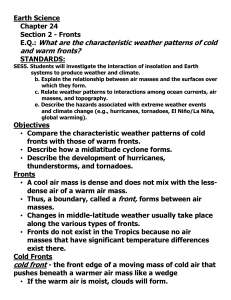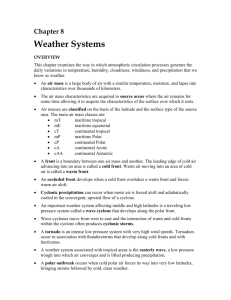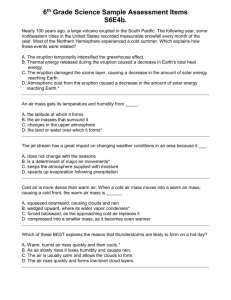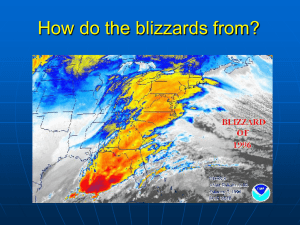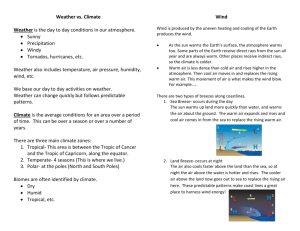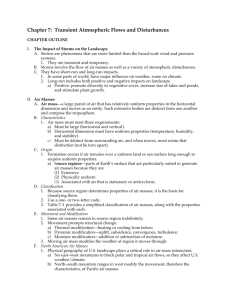Week10 CWS-A: Midlatitude Extratropical Cyclones At the beginning
advertisement
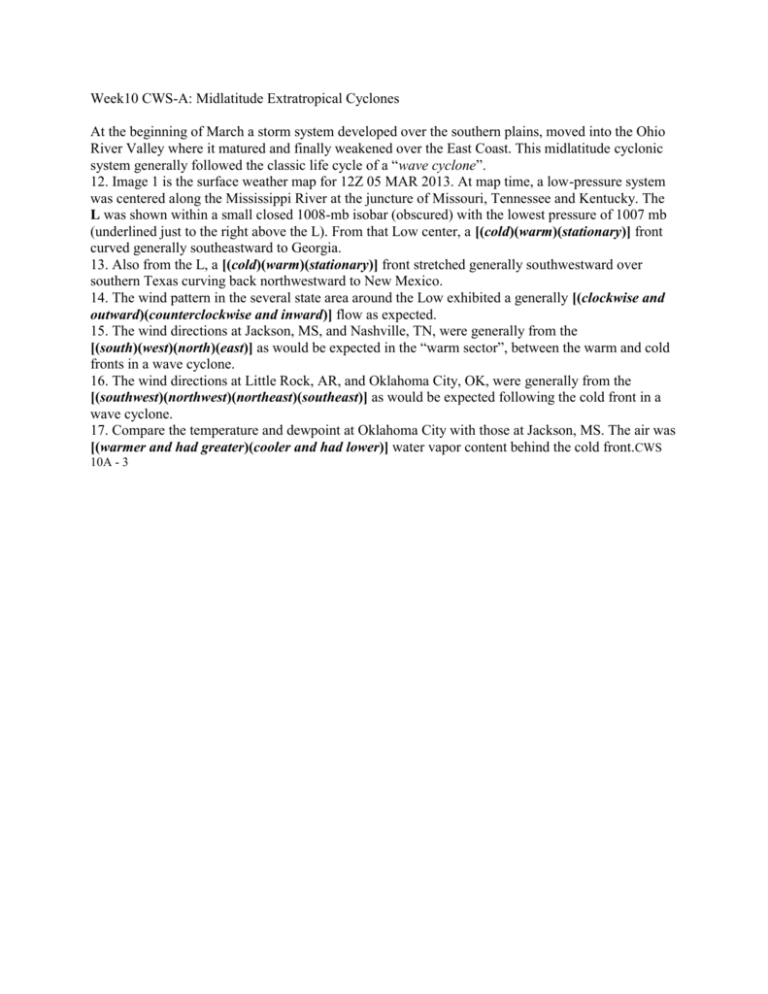
Week10 CWS-A: Midlatitude Extratropical Cyclones At the beginning of March a storm system developed over the southern plains, moved into the Ohio River Valley where it matured and finally weakened over the East Coast. This midlatitude cyclonic system generally followed the classic life cycle of a “wave cyclone”. 12. Image 1 is the surface weather map for 12Z 05 MAR 2013. At map time, a low-pressure system was centered along the Mississippi River at the juncture of Missouri, Tennessee and Kentucky. The L was shown within a small closed 1008-mb isobar (obscured) with the lowest pressure of 1007 mb (underlined just to the right above the L). From that Low center, a [(cold)(warm)(stationary)] front curved generally southeastward to Georgia. 13. Also from the L, a [(cold)(warm)(stationary)] front stretched generally southwestward over southern Texas curving back northwestward to New Mexico. 14. The wind pattern in the several state area around the Low exhibited a generally [(clockwise and outward)(counterclockwise and inward)] flow as expected. 15. The wind directions at Jackson, MS, and Nashville, TN, were generally from the [(south)(west)(north)(east)] as would be expected in the “warm sector”, between the warm and cold fronts in a wave cyclone. 16. The wind directions at Little Rock, AR, and Oklahoma City, OK, were generally from the [(southwest)(northwest)(northeast)(southeast)] as would be expected following the cold front in a wave cyclone. 17. Compare the temperature and dewpoint at Oklahoma City with those at Jackson, MS. The air was [(warmer and had greater)(cooler and had lower)] water vapor content behind the cold front.CWS 10A - 3 18. Precipitation, as represented by the radar echo shadings on the map, was intense where yellow and red shadings existed. These heaviest rainfall rates were located [(ahead of the warm front)(in the warm sector between the warm and cold fronts) (along the cold front)(in all these locations)]. Additionally, lighter precipitation extended northwestward along a dashed orange trough line, the remnants of an old front. 19. Image 2 is the 500-mb upper-air map for 12Z 05 MAR 2013, the same time as the Image 1 surface map. Place a bold “L” on the Image 2, 500-mb map where the surface 1007-mb Low center of Image 1 was shown. The center of the storm system at the surface, as marked by the L you drew, was located to the east side of an upper air [(ridge)(trough)] shown on the 500-mb map over the central U.S. 20. Wind directions at 500 mb over surface weather features are often a good indicator of the movements of those systems over the next day or so. Based on the wind directions at 500 mb as inferred by the station plots and contour lines over the area of the surface storm center, the system would be expected to move generally toward the [(east)(north)(west) (south)] over the next day. 21. Now look back to the Image 1 surface map. Based on the frontal symbols, the cold front stretching from Missouri to Texas would be expected to move generally toward the [(southwest)(southeast)(northwest)]. The warm front, as expected from the analysis, would likely move a little toward the northeast over the same period. 22. Image 3 is the surface weather map for 00Z 06 MAR 2013, half a day after Images 1 and 2. By Image 3 the wave cyclone had begun to mature as seen by the formation of a short [(cold)(warm)(occluded)] front. The junction of three fronts in western South Carolina is termed a “triple point”. These maps display the classic development of this latter stage of a midlatitude wave cyclone. 23. By Image 3, the cold front was shown to have advanced generally toward the [(southwest) (southeast)(northwest)]. 24. The 1007-mb low-pressure center of Image 1 was now located in eastern Kentucky with a minimum pressure of 1000 mb. Comparing the Image 1 and 3 surface maps shows that the movement of the original low-pressure center between the surface map times [(did)(did not)] generally follow the direction of the middle-tropospheric (500 mb) wind directions in that region as seen on Image 2. This verifies your answer to question 209. 25. In the 12 hours between surface maps, the central pressure had fallen (decreased) by [(2)(4)(7)] mb. During the life cycle of a wave cyclone, the central pressure typically falls until the system achieves full maturity, then rises as the system weakens and continues occlusion.CWS 10A - 4 26. On Image 3, the precipitation pattern is seen [(ahead of the cold front) (spread from the warm front along the occluded front and trough line) (in both locations indicated)]. 27. By Image 3 map time, following cold frontal passage, the dewpoint at Jackson, MS, indicated the water vapor content of the air was [(more)(unchanged)(less)] than the that in the air that preceded the front. By 12Z 06 MAR, a day after Image 1 and a half-day after Image 3, the temperature at Jackson had fallen to 38 degrees Fahrenheit! The NWS National Centers for Environmental Prediction (NCEP) also create surface maps for North America, the continental U.S., Alaska, Hawaii or sections of the country, in either black and white or color, with or without fronts, and/or with satellite or radar data. These maps can also be found from the “NWS Surface Analyses” link on the course website under Surface products. Also, one- and seven-day loops of frontal positions can be created showing the progression of surface weather features. The National Weather Service Unified Surface Analysis will even show (and animate) wave cyclones and Highs across most of the Northern Hemisphere. Take note of these the maps as increasingly intense cyclones form and move across the country with the progression of spring. Answer the Current Weather Studies activities on the CWS Answer Form (provided from the course website on Wednesdays). Return to DataStreme Atmosphere website ©Copyright 2013, American Meteorological Society


